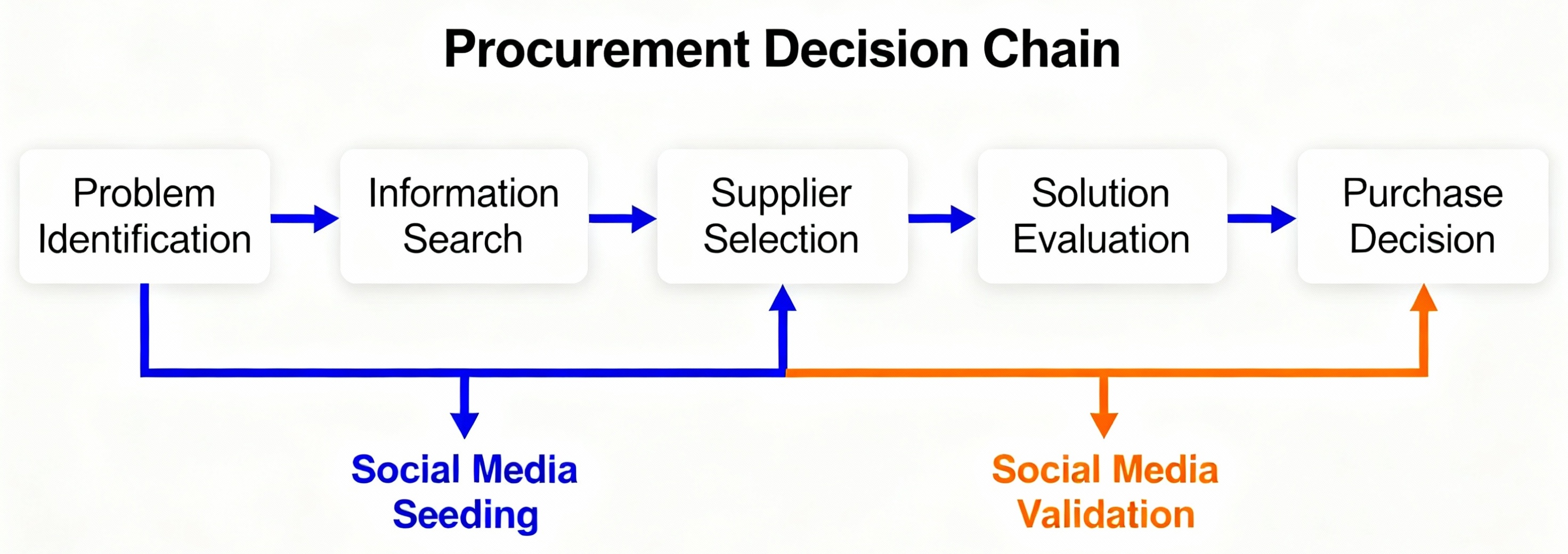Social media is reshaping the global industrial procurement decision chain.
In the past, overseas customer acquisition for manufacturing companies largely relied on trade shows, search engine marketing (SEM), and email campaigns (EDM).
By 2025, a clear shift has emerged — social media has become an integral part of the global B2B purchasing decision process.
According to Articulate Marketing, over half of B2B buyers used LinkedIn to assist their purchase decisions in the past year. Meanwhile, a B2B House survey revealed that 78% of B2B marketers consider LinkedIn the most effective platform for achieving business goals.
In other words: if your brand is “invisible” on social media, you are likely being systematically ignored by high-quality prospects.

I. Three Major Social Media Trends for Manufacturing Brands in 2025
📈Trend 1: From Brand Exposure to Trust-Building — Social Media as a New Arena for Technical Credibility
In manufacturing, social media has evolved from a promotional channel to a pre-validation tool for technical reliability.
Case:
A Chinese laser equipment manufacturer posted a “precision cutting test video” on LinkedIn. It was later shared by a German integrator in an internal engineering group, eventually leading to a sample order.
Data Insight:
Edelman Trust Barometer report, “My Employer: The Key to the Trust Puzzle”, shows that employees and professional experts are among the most trusted sources of information.
💡 Landelion Insight:
Before sending a formal inquiry, overseas clients now use social media as an “invisible due diligence” step to evaluate a supplier’s technical competence.
📈Trend 2: Rise of Professionalized Content — Long-Form and Video Lead the Way
By 2025, overseas industrial audiences are showing strong preference for specialized, visual, and in-depth content.
Content Type | Popularity (LinkedIn Data) | Typical Use Case |
Technical deep dives (“How to choose a servo motor”) | ⭐⭐⭐⭐ | Drives search traffic and builds expertise |
Factory footage / testing videos | ⭐⭐⭐⭐⭐ | Showcases manufacturing capability and credibility |
Customer case studies | ⭐⭐⭐ | Provides social proof and reduces risk perception |
Product animation / 3D demos | ⭐⭐⭐⭐ | Visualizes complex technology and enhances understanding |
💡 Landelion Tip:
Educational or explainer videos (such as product tutorials and technical walkthroughs) achieve significantly higher viewer retention. Many industrial tech YouTube channels now report average watch times of several minutes — indicating that B2B audiences are highly engaged with high-value content.
📈Trend 3: Employee Advocacy — Human Voices Drive Authentic Trust
Compared to official corporate accounts, posts by engineers, project managers, and salespeople generate higher engagement and trust.
Case:
A u-blox engineer shared a LinkedIn post titled “The EMI Challenges Behind Our Module Design”, receiving 200+ interactions and direct outreach from multiple OEM partners.
Data Insight:
According to Hootsuite, employee-shared posts get 8× more engagement and 2× higher click-through rates than corporate accounts.
💡 Landelion Recommendation:
Empower your engineers and field experts to participate in content co-creation. Let human expertise convey brand credibility.
II. How Social Media Influences B2B Purchasing Decisions
Many manufacturers still believe “social media doesn’t generate orders.”
However, social media now plays a critical role in the early stages of the B2B decision cycle:

Stage 1 – Information Search:
A purchasing manager searches “high precision linear guide supplier” and clicks on a YouTube video or LinkedIn article from your company.
Stage 2 – Supplier Shortlist:
Company A consistently shares technical insights, while Company B only posts press releases — A makes the shortlist.
Stage 3 – Solution Evaluation:
The buyer forwards your LinkedIn case study internally:
“We’ve seen this company — they’ve done similar projects.”
✅ Conclusion:
Social media may not directly close deals, but it strongly influences who makes it onto the final shortlist.
III. ROI Analysis: The Logic Behind Social Media Returns
Many manufacturing companies ask:
“How much should we invest in social media?”
“How do we measure its ROI?”
Based on Landelion’s experience serving global industrial clients like Schenck Group and Halma Group, we summarize three ROI dimensions for social media in manufacturing:
ROI Dimension | Metrics | Actual Results |
Brand Equity | LinkedIn follower growth, content impressions, keyword ranking | A client doubled its followers in 6 months and ranked within Google’s top 3 pages |
Lead Generation | Downloads, inquiries, web traffic increase | One technical article generated dozens of qualified leads and sample orders |
Sales Enablement | Sales feedback, negotiation cycle | Prospects referenced “your YouTube videos” in first meetings, reducing trust barriers |
💡 Landelion Insight:
Typical ROI cycle: 6–12 months (requires consistency)
Budget allocation: 70% content creation + 20% community management + 10% tools
Highest ROI content: Technical insights > Product promos; Real scenarios > Concept visuals
IV. Four-Step Roadmap for Global Social Media Growth
To help manufacturers systematically scale global social media, Landelion recommends a 4-step roadmap:
Step 1: Platform Selection & Account Setup
Primary platforms: LinkedIn (B2B decision-makers), YouTube (visual storytelling)
Supporting channels: X/Twitter (industry updates), Facebook/Instagram (factory culture)
Setup checklist: Consistent branding (VI), English bio, website link, and clear contact details.
Step 2: Content Strategy & Editorial Calendar
Content Mix:
l 40% Technical insights (guides, standards interpretation)
l 30% Application stories (case studies, test videos)
l 30% Brand narrative (R&D, sustainability)
Posting frequency: LinkedIn: 2–3 posts/week; YouTube: 1–2 high-quality videos/month
Step 3: Team Collaboration & Employee Empowerment
Form a social media content committee including marketing, technical, and sales departments.
Create employee social participation guidelines for consistent tone and risk control.
Host monthly content co-creation sessions to collect authentic materials from engineers and sales teams.
Step 4: Analytics & Optimization
Core KPIs: Impressions, engagement rate, website traffic, direct message conversions
Recommended tools: LinkedIn Analytics, Google Analytics, HubSpot
Review cycle: Quarterly content and budget optimization
Conclusion: In 2025, Social Media Is No Longer Optional
Global industrial competition has evolved beyond price and product performance — it now includes brand expertise and digital influence.
A professional, active, and value-driven social media presence allows your brand to:
✅ Be visible when customers search
✅ Stand out during supplier selection
✅ Win trust earlier in negotiations
Social media is no longer a “supporting channel” — it is the core growth engine for global manufacturing expansion.
📥 Get Your Free Copy:
“Manufacturing Social Media ROI Calculator & Planning Template”
This practical tool helps you:
🔹Simulate annual budget allocation
🔹Forecast ROI by content type
🔹Track KPIs across platforms
🔹Compare channel performance
👉 Click here to download now: ![]() Manufacturing Social Media ROI Calculator & Planning Template.xlsx
Manufacturing Social Media ROI Calculator & Planning Template.xlsx
📚 Further Reading
Five Social Media Strategies for Manufacturing Brands Going Global




